Analog chipmaker Microchip Technology (NASDAQ:MCHP) missed analysts' expectations in Q1 CY2024, with revenue down 40.6% year on year to $1.33 billion. Next quarter's revenue guidance of $1.24 billion also underwhelmed, coming in 8.7% below analysts' estimates. It made a non-GAAP profit of $0.57 per share, down from its profit of $1.64 per share in the same quarter last year.
Microchip Technology (MCHP) Q1 CY2024 Highlights:
- Revenue: $1.33 billion vs analyst estimates of $1.34 billion (1.2% miss)
- EPS (non-GAAP): $0.57 vs analyst expectations of $0.57 (in line)
- Revenue Guidance for Q2 CY2024 is $1.24 billion at the midpoint, below analyst estimates of $1.36 billion
- Gross Margin (GAAP): 59.6%, down from 68% in the same quarter last year
- Inventory Days Outstanding: 223, up from 185 in the previous quarter
- Free Cash Flow of $389.9 million, down 50.9% from the previous quarter
- Market Capitalization: $49.37 billion
Spun out from General Instrument in 1987, Microchip Technology (NASDAQ: MCHP) is a leading provider of microcontrollers and integrated circuits used mainly in the automotive world, especially in electric vehicles and their charging devices.
Microchip is a leading provider of microprocessors (MPUs) which are made up of microcontrollers (MCUs) and Digital Signal Controllers (DSCs). Microcontrollers are effectively mini computers on a chip, they consist of a CPU, some memory, an analog chip, and a simple, application specific software that tells the chip what to do.
Microchip’s microcontrollers are low cost customized chips that are in thousands of products. Examples would be automobile engine control systems, implantable medical devices, remote controls, office machines, appliances, power tools, or toys.
Digital Signal Controllers are a variation of microcontroller that measures, filters and/or compresses digital or analog signals. They are used in motor control, power conversion, and sensor processing applications, often in the same types of systems as a microcontroller.
Microchip has a design ecosystem and library of off-the-shelf components that allows its customers to design any kind of custom microprocessor they can think of.
Microchips’ peers and competitors include Texas Instruments (NASDAQ:TXN), Skyworks (NASDAQ:SWKS), and Infineon (XTRA:IFX), among others.Analog Semiconductors
Longer manufacturing duration allows analog chip makers to generate greater efficiencies, leading to structurally higher gross margins than their fabless digital peers. The downside of vertical integration is that cyclicality can be more pronounced for analog chipmakers, as capacity utilization upsides work in reverse during down periods.
Sales Growth
Microchip Technology's revenue growth over the last three years has been mediocre, averaging 13.6% annually. This quarter, its revenue declined from $2.23 billion in the same quarter last year to $1.33 billion. Semiconductors are a cyclical industry, and long-term investors should be prepared for periods of high growth followed by periods of revenue contractions (which can sometimes offer opportune times to buy).
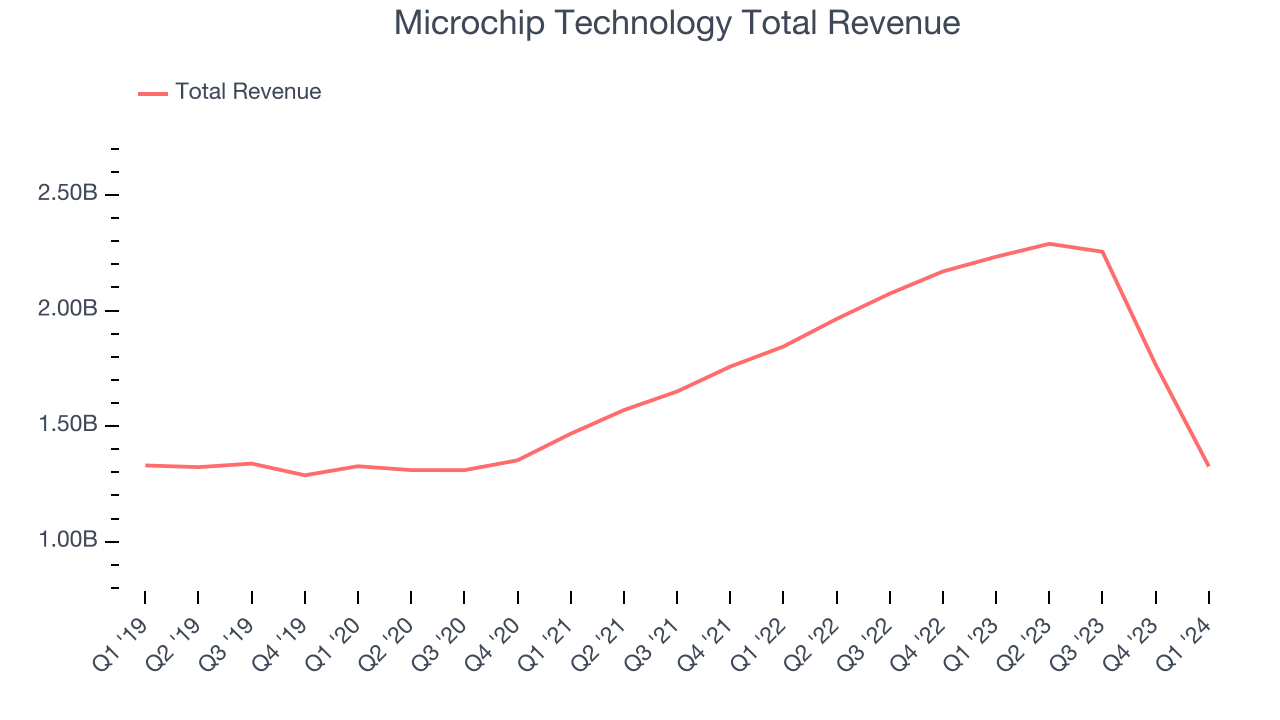
Microchip Technology had a difficult quarter as revenue dropped 40.6% year on year, missing analysts' estimates by 1.2%. This could mean that the current downcycle is deepening.
Microchip Technology's revenue growth has decelerated over the last three quarters and its management team projects revenue to fall next quarter. As such, the company is guiding for a 45.8% year-on-year revenue decline while analysts are expecting a 15.9% drop over the next 12 months.
Product Demand & Outstanding Inventory
Days Inventory Outstanding (DIO) is an important metric for chipmakers, as it reflects a business' capital intensity and the cyclical nature of semiconductor supply and demand. In a tight supply environment, inventories tend to be stable, allowing chipmakers to exert pricing power. Steadily increasing DIO can be a warning sign that demand is weak, and if inventories continue to rise, the company may have to downsize production.

This quarter, Microchip Technology's DIO came in at 223, which is 85 days above its five-year average, suggesting that the company's inventory has grown to higher levels than we've seen in the past.
Pricing Power
In the semiconductor industry, a company's gross profit margin is a critical metric to track because it sheds light on its pricing power, complexity of products, and ability to procure raw materials, equipment, and labor. Microchip Technology's gross profit margin, which shows how much money the company gets to keep after paying key materials, input, and manufacturing costs, came in at 59.6% in Q1, down 8.5 percentage points year on year.
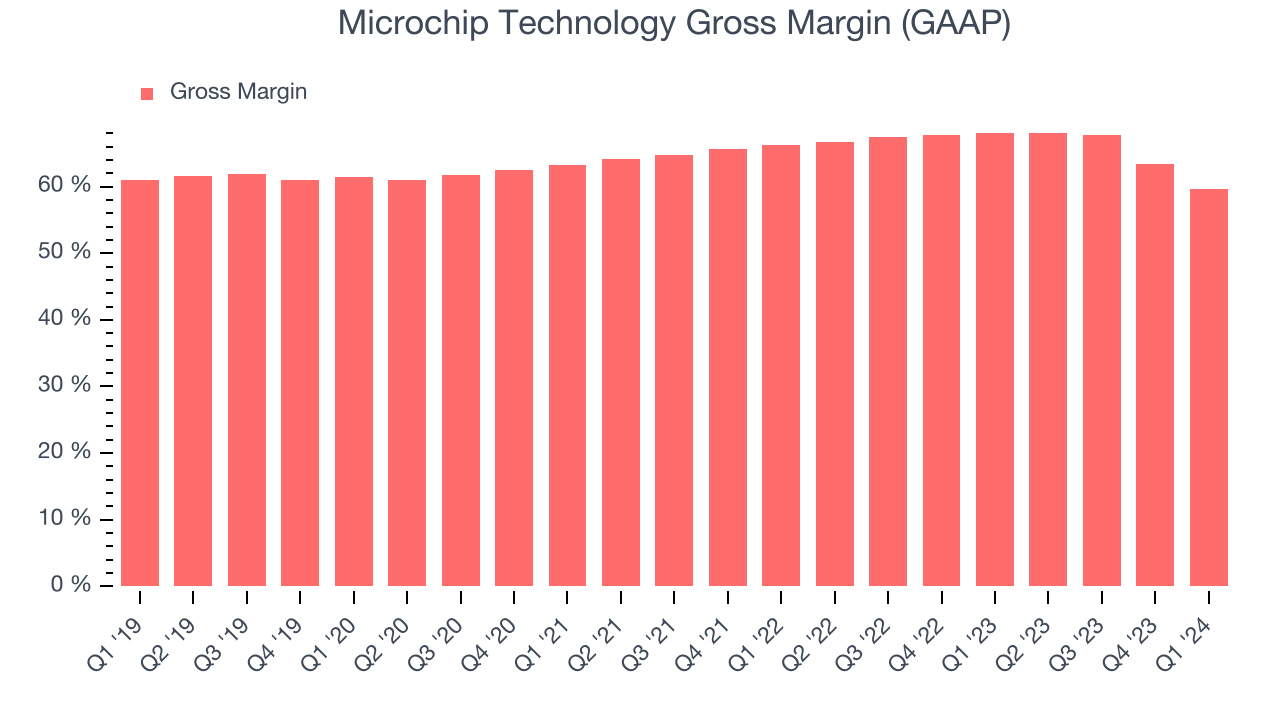
Gross margins have been trending down over the last year, averaging 65.4%. However, Microchip Technology's elite margins are some of the best in the semiconductor industry, driven by strong pricing power from its differentiated, value-add products.
Profitability
Microchip Technology reported an operating margin of 32.9% in Q1, down 14.8 percentage points year on year. Operating margins are one of the best measures of profitability because they tell us how much money a company takes home after manufacturing its products, marketing and selling them, and, importantly, keeping them relevant through research and development.
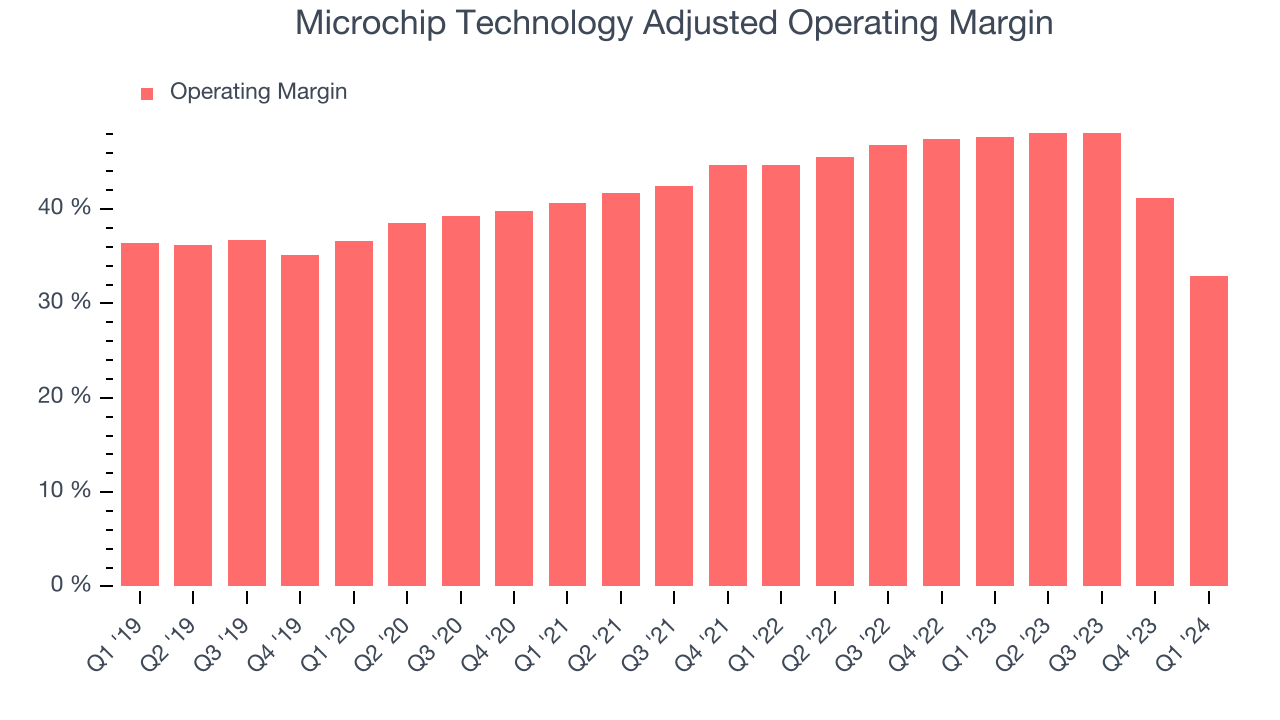
Microchip Technology's operating margins have been trending down over the last year, averaging 43.9%. However, the company's profitability remains one of the highest in the industry, driven by its strong gross margins and economies of scale generated from its highly efficient operating model.
Earnings, Cash & Competitive Moat
Wall Street expects earnings per share to decline 22.9% over the next 12 months, although estimates will likely change after earnings.
Although earnings are important, we believe cash is king because you can't use accounting profits to pay the bills. Microchip Technology's free cash flow came in at $389.9 million in Q1, down 34.7% year on year.
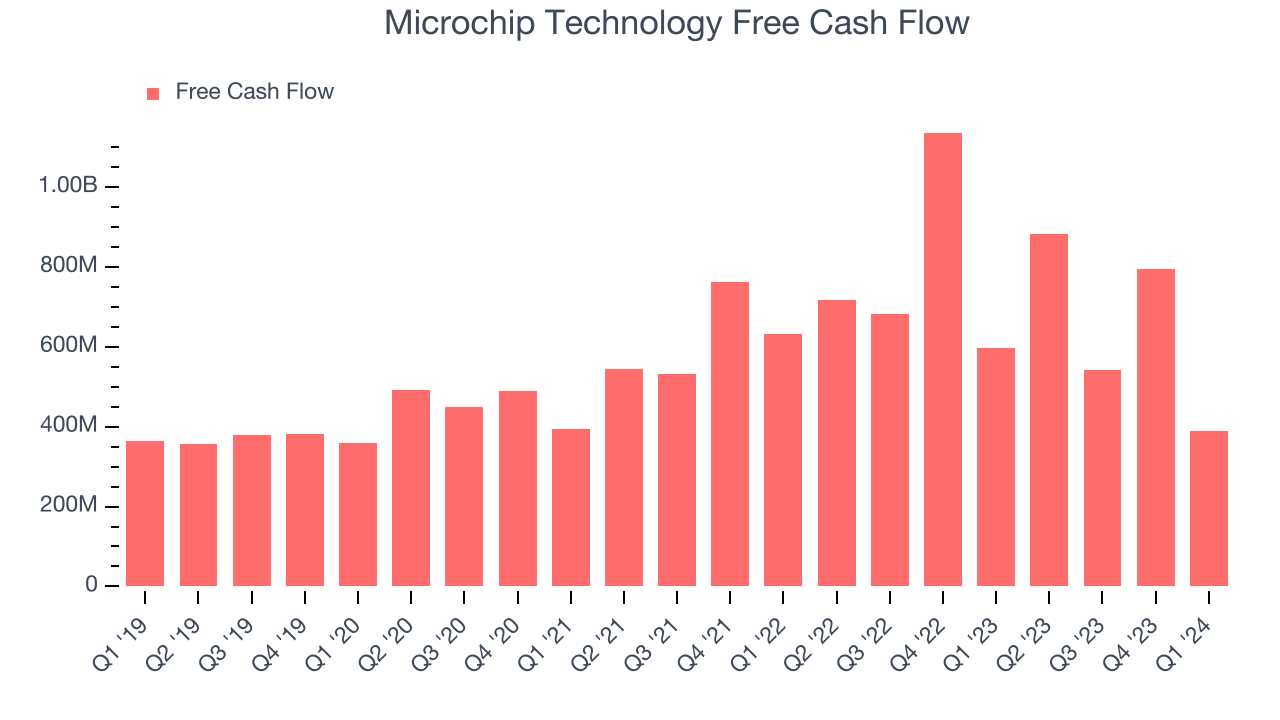
As you can see above, Microchip Technology produced $2.61 billion in free cash flow over the last 12 months, an eye-popping 34.2% of revenue. This is a great result; Microchip Technology's free cash flow conversion places it among the best semiconductor companies and, if sustainable, puts the company in an advantageous position to invest in new products while remaining resilient during industry downturns.
Return on Invested Capital (ROIC)
EPS and free cash flow tell us whether a company was profitable while growing revenue. But was it capital-efficient? Enter ROIC, a metric showing how much operating profit a company generates relative to how much money the business raised (debt and equity).
Microchip Technology's five-year average ROIC was 12.5%, somewhat low compared to the best semiconductor companies that consistently pump out 35%+. Its returns suggest it historically did a subpar job investing in profitable business initiatives.
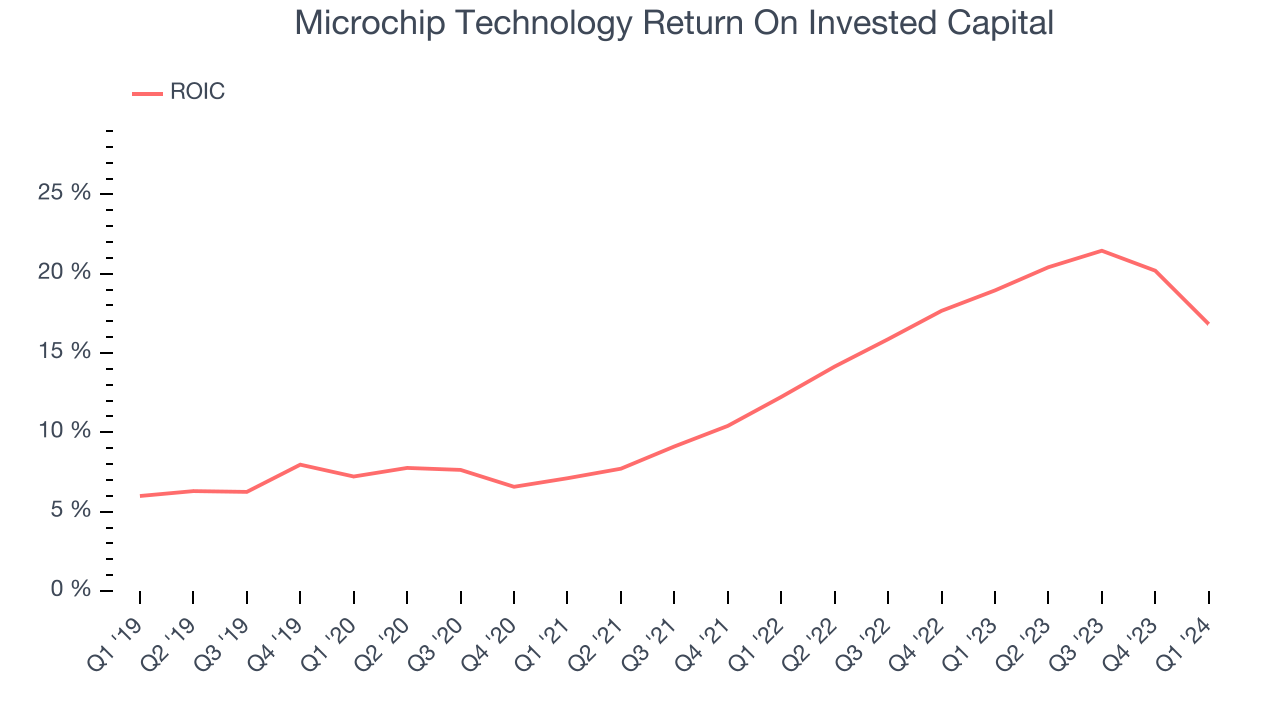
The trend in its ROIC, however, is often what surprises the market and drives the stock price. Over the last few years, Microchip Technology's ROIC averaged 10.7 percentage point increases. This is a good sign, and if the company's returns keep rising, there's a chance it could evolve into an investable business.
Key Takeaways from Microchip Technology's Q1 Results
We struggled to find many strong positives in these results. Its revenue missed as its customers continued reducing their inventories. Its guidance for next quarter also fell short of analysts' expectations - management noted it's seeing "signs of demand stabilization but [is] experiencing low business visibility due to short lead times and the continued macro uncertainty".
On the bright side, the company announced a quarterly dividend of $0.45 per share, up 18% year on year. The dividend will be payable to investors as of May 22, 2024 on June 5, 2024.
Overall, this was a bad quarter for Microchip Technology. The company is down 4.7% on the results and currently trades at $89.4 per share.
Is Now The Time?
When considering an investment in Microchip Technology, investors should take into account its valuation and business qualities as well as what's happened in the latest quarter.
Although Microchip Technology is't a bad business, it probably wouldn't be one of our picks. Its revenue growth has been mediocre over the last three years, but at least growth is expected to increase in the short term. And while its powerful free cash generation enables it to sustainably invest in growth initiatives while maintaining an ample cash cushion, unfortunately, its relatively low ROIC suggests it has struggled to grow profits historically.
Microchip Technology's price-to-earnings ratio based on the next 12 months is 31.7x. We can find things to like about Microchip Technology and there's no doubt it's a bit of a market darling, at least for some investors. But it seems that there's a lot of optimism already priced in and we wonder whether there might be better opportunities elsewhere right now.
Wall Street analysts covering the company had a one-year price target of $93.69 per share right before these results (compared to the current share price of $89.40).
To get the best start with StockStory check out our most recent Stock picks, and then sign up to our earnings alerts by adding companies to your watchlist here. We typically have the quarterly earnings results analyzed within seconds of the data being released, and especially for the companies reporting pre-market, this often gives investors the chance to react to the results before the market has fully absorbed the information.
